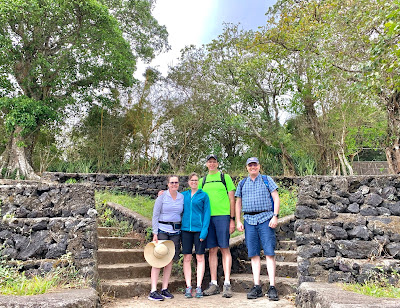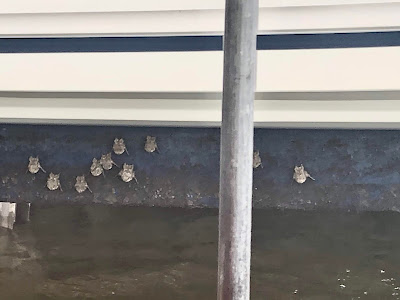Our second day in Costa Rica we actually spent in Nicaragua. Brad and Matt really wanted to take a day-trip to Nicaragua, and to be honest it really wasn't that high on my wish-list. However, in my opinion, the time (almost 24 hours) we spent in Southern Nicaragua was truly the highlight of our entire Costa Rican trip!
Our trip to Nicaragua included breakfast in Rivas on Lake Nicaragua, shopping and walking the hills of Catarina while taking pictures of Apoyo Lagoon, seeing actual lava inside the Masaya Volcano, taking a boat ride through the Islet's of Granada, and eating and exploring the history-rich city of Granada!
Our day began in the wee hours of the morning in order to get across the boarder in a timely manner. During the drive, north, our tour guide, Urial (who's originally from Nicaragua), taught us all about Nicaragua from it's history and government, to it's geology, natural resources, and tourism.
It seemed like security at the border of Costa Rica and Nicaragua was pretty tight. Urial was pretty serious when he gave us very specific directions of what to do and how to act. We had to cross on foot as we handed him our passports and followed him through various buildings, as he spoke with different border patrol people. We also had our core temperatures taken since it was the beginning of Covid 19. I was just glad Urial had the right "connections" and was able to get us through without a hitch! Once in Nicaragua and back in our car again, we passed by trucks that were lined up for miles and miles. Urial told us that sometimes it took days for the trucks to get across the border!
Our first stop in Nicaragua was Rivas, where we would be eating breakfast. The road to Rivas was green and lush with thick trees canopying the roadway.
Our driver and tourist van. There was one more couple in addition to the six people in our group.
Typical outdoor Nicaraguan restaurant with thatched roof.
Our tour group and wonderful waiter.
Breakfast was delicious, and I especially loved feeling the cool breezes from Lake Nicaragua as we ate.
We has a typical Nicaraguan breakfast of eggs, rice, beans, plantains, and freshly-squeezed mango juice.
Matt and Brei taking pictures of Lake Nicaragua.
Deb and Les also taking pictures as Debbie tries to keep her hat from flying away (it really was a miracle that Debbie didn't lose her hat!).
Fun-Fact: Lake Nicaragua is a freshwater lake and the largest lake in Central America (19th largest in world).
From January through May winds on the lake are very strong, thus the numerous windmills dotting the shoreline. I also loved the white birds properly "social distancing" themselves on the beach.
Nicaragua is known for it's many lakes and volcanoes, as seen here in the distance.
All that stuff on the beach is actually water hyacinths and lettuce, which continually wash-up on shore.
Like Costa Rica, Nicaragua has the most colorful indigenous plants.
After breakfast we were able to see much of the countryside on our drive to the bigger cities.
Sugar cane is one of Nicaragua's top exports,
and beef one of it's top producers.
However, some of those cows looked awfully thin with their ribs sticking out, which makes sense considering the grass they were eating on the sides of the road looked more like dirt than anything else.
I've never seen so many fruit stands either, which also makes sense since it's many families' only source of income. Nicaragua is the poorest country in Central America and the second poorest in the Western Hemisphere. Many people only make 2-3 dollars a day, but in recent years, tourism has been on the rise, and has shown much promise for the country's economy.
Nicaraguan girl walking to school dressed in her school uniform.
School children "out for recess" on the school grounds which are just fields of dirt.
Because of overcrowding, the public school system is divided into two groups with the younger children attending school during the morning hours, and the older students going to school in the afternoon.
Due to the high poverty rate, public schools in Nicaragua have struggled, but emphasis on literacy, retention, and funding for improved and higher learning, are now becoming a priority.
I loved all the old churches. Fifty percent of Nicaraguans are Roman Catholic.
Horse and buggy--still a regular form of transportation,
or delivering goods.
Rickshaw, another common form of transportation.
Driving through the quaint town of Catarina.
Another brightly colored old church!
We were encouraged to buy souvenirs from the vendors themselves,
so that they would have money to feed their families.
Mirador de Catarina, or viewpoint from Catarina,
of the beautiful Apoyo Lagoon,
located between Granada, the Masaya volcano,
and the Mombacho volcanoes.
Another perfect place for lots of pictures...
You could even tour the park via horseback.
Exploring Catarina State Park...
The perfect picture platform!
Unique old trees (just a tad bit bigger than our trees in Kentucky)!
Debbie hanging onto her hat, and looking mighty stylish in the process.
We then drove to the Masaya Volcano.
The black lava rock flowing down the mountain amidst fields of sage and grass was enchanting.
The Masaya volcano is a very active volcano. It last spewed ash Oct 2019, and last erupted in 2016.
Masaya volcano lookout points
Our group with tour guide Urial
Looking deep into the volcano
Another great photo-op...
Brad trying to throw me into the volcano (good thing I'm
too heavy)
Heavy steam spewing from the crater...
We were only allowed to look into the volcano for fifteen minuets because breathing in the steam could be toxic.
Colorful lava rock
Zooming in with my phone's camera to see the bubbling lava in the center!
It was so amazing to see actual red boiling lava! The Masaya volcano is one of few in the world with view of a lava river!
Our next adventure was a boat tour of the Islets of Granada. On the drive to Granada we saw some fun sites...
more interesting forms of transportation,
statue of Christ in the middle of the road,
rows and rows of brightly colored homes,
and my favorite...
lots of school-aged children in their uniforms walking to and from school.
Getting our life jackets buckled-up for our boat tour of the famous Granada Islets.
Trolling to open water
Another unique tree arching over the water
On Lake Nicaragua there is an archipelago of 365 islands formed by eruptions of the Mombacho volcanoes.
Beautiful view of rain clouds ascending onto Lake Nicaragua.
Fish in the lake include among others tuna, rooster fish, snook, tarpon and the extraordinary freshwater bull shark!
The Islets of Granada include...
uninhabited islands,
traditional villages,
private residences,
and luxurious resorts (this one is just being built)!
Nicaragua has 12,000 species of plants, including mosses, lichens, and orchids (my favorite) that grow in cloud & rain-forests.
There are 764 different species of birds in Nicaragua.
There are three native monkeys that include Capuchins, Howler, and Spider monkeys.
The white-faced Capuchin monkeys are sneaky and playful. Urial put some bananas on the front of our boat to lure this little guy in.


Brown Spider monkeys...
playing in the trees,
There were even bats sleeping on the side of this boat!
Fun Fact: Vampire bats can be found on the mainland sticking to livestock.
Fun Fact: Vampire bats can be found on the mainland sticking to livestock.
Another Fun Fact: Other indigenous creatures of Nicaragua include pumas, jaguars, five kinds of sea turtles, frogs, snakes, scorpions, tarantulas, ants,1000 species of butterflies, and this iguana that Les and Deb spotted.
After our tour of the islands it was time to explore Granada itself. Granada is the oldest city in Nicaragua (founded 1524) and was the first city founded by the Spaniards in Central America. Brad and I standing in front of the famous Love sign which can also be found in other parts of the world.
Stunning view of Lake Nicaragua from Granada's lakefront--not quite reaching it's intended grandiose potential due to the cost of upkeep.
Church on the waterfront with the prettiest foliage!
Our delicious lunch in Granada!
I had the sea-bass, rice, fries, salad, and fresh passion fruit juice. Did I mention that I became a fish-eater while in CR and Nicaragua? Now that I'm back in the states, I am no longer one (the fish is too fishy-tasting).
Our little tour-group again, which included a retired couple from Toronto, Canada.
After lunch we walked the streets of Granada with our tour guide as he articulated more interesting facts.
The buildings are made of bricks and mud. The left side of this picture shows what the exterior looked like before it was plastered and painted.
A closer look at the inside of the walls.
A change in the color of the exterior walls represented a new family's dwelling, since most of the homes downtown were all connected.
Many of the buildings were colonial style
The outsides of the buildings were simple, but once inside they really opened up, and some were quite elaborate like this hotel.
Beautiful mosaics and waterfall in the middle of the hall.
Most of the homes and/or hotels also had open courtyards where the breezes could blow through.
Fancy courtyard in the middle of another hotel.
Nicaragua has more than 30 species of hardwood including mahogany, which these doors were made out of.
Thatched mahogany ceiling with chandelier
School in downtown Granada. The quality of living was definitely higher in the cities, especially in Granada, but that's because the cost of living was also much higher.
Canopy of umbrellas on the Avenia La Calzada, which totally comes alive at night with live music, eating, and lots of drinking.
Patron carrying bread-for-sale on his head.
Old church on famous Los Mangos street, which is known for it's quiet, tree-lined, cobblestone pavement and bike-riders instead of cars.
Iglesia La Merced Catholic church built in 1534,
and located on Los Mangos street.
Our Lady of the Assumption Cathedral also called Granada Cathedral, built around 1525.
Taking our hats off and getting ready to sneak inside the church with Urial.
The reason we were sneaking is because there was an active service going on.
I tried to take pictures as inconspicuously as possible.
Priest conducting the service.
Additional place for praying.
Amazing arches, columns,
and tiled floors!
Interesting stained-glass window, and mahogany confession booth.
And the piece de resistance...
the crucified Christ hanging from the ceiling.
Also of honorable mention, the massive sky-blue rotunda and dome,
and vibrantly detailed ceiling frescoes...
View of Granada Cathedral from Granada Central Park
or Parque Colon de Granada,
which was a popular gathering place for locals and tourists alike. People come to relax, play, or buy food, goods, and services from the many vendors lining the streets.
Carriage rides, one of the most popular ways to see the city without all the walking!
Last but not least was Palacio Episcopal, a colonial-style working convent that was setting up chairs for some kind of celebration.

















































































































































